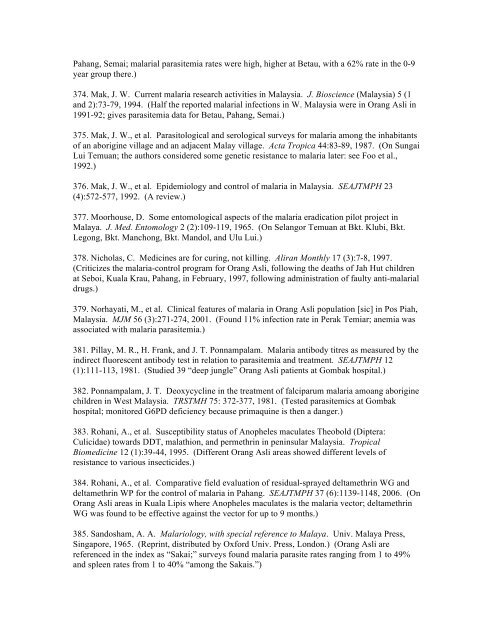Orang Asli (Indigenous Malaysian) Biomedical Bibliography AS Baer
Orang Asli (Indigenous Malaysian) Biomedical Bibliography AS Baer
Orang Asli (Indigenous Malaysian) Biomedical Bibliography AS Baer
You also want an ePaper? Increase the reach of your titles
YUMPU automatically turns print PDFs into web optimized ePapers that Google loves.
Pahang, Semai; malarial parasitemia rates were high, higher at Betau, with a 62% rate in the 0-9<br />
year group there.)<br />
374. Mak, J. W. Current malaria research activities in Malaysia. J. Bioscience (Malaysia) 5 (1<br />
and 2):73-79, 1994. (Half the reported malarial infections in W. Malaysia were in <strong>Orang</strong> <strong>Asli</strong> in<br />
1991-92; gives parasitemia data for Betau, Pahang, Semai.)<br />
375. Mak, J. W., et al. Parasitological and serological surveys for malaria among the inhabitants<br />
of an aborigine village and an adjacent Malay village. Acta Tropica 44:83-89, 1987. (On Sungai<br />
Lui Temuan; the authors considered some genetic resistance to malaria later: see Foo et al.,<br />
1992.)<br />
376. Mak, J. W., et al. Epidemiology and control of malaria in Malaysia. SEAJTMPH 23<br />
(4):572-577, 1992. (A review.)<br />
377. Moorhouse, D. Some entomological aspects of the malaria eradication pilot project in<br />
Malaya. J. Med. Entomology 2 (2):109-119, 1965. (On Selangor Temuan at Bkt. Klubi, Bkt.<br />
Legong, Bkt. Manchong, Bkt. Mandol, and Ulu Lui.)<br />
378. Nicholas, C. Medicines are for curing, not killing. Aliran Monthly 17 (3):7-8, 1997.<br />
(Criticizes the malaria-control program for <strong>Orang</strong> <strong>Asli</strong>, following the deaths of Jah Hut children<br />
at Seboi, Kuala Krau, Pahang, in February, 1997, following administration of faulty anti-malarial<br />
drugs.)<br />
379. Norhayati, M., et al. Clinical features of malaria in <strong>Orang</strong> <strong>Asli</strong> population [sic] in Pos Piah,<br />
Malaysia. MJM 56 (3):271-274, 2001. (Found 11% infection rate in Perak Temiar; anemia was<br />
associated with malaria parasitemia.)<br />
381. Pillay, M. R., H. Frank, and J. T. Ponnampalam. Malaria antibody titres as measured by the<br />
indirect fluorescent antibody test in relation to parasitemia and treatment. SEAJTMPH 12<br />
(1):111-113, 1981. (Studied 39 “deep jungle” <strong>Orang</strong> <strong>Asli</strong> patients at Gombak hospital.)<br />
382. Ponnampalam, J. T. Deoxycycline in the treatment of falciparum malaria amoang aborigine<br />
children in West Malaysia. TRSTMH 75: 372-377, 1981. (Tested parasitemics at Gombak<br />
hospital; monitored G6PD deficiency because primaquine is then a danger.)<br />
383. Rohani, A., et al. Susceptibility status of Anopheles maculates Theobold (Diptera:<br />
Culicidae) towards DDT, malathion, and permethrin in peninsular Malaysia. Tropical<br />
Biomedicine 12 (1):39-44, 1995. (Different <strong>Orang</strong> <strong>Asli</strong> areas showed different levels of<br />
resistance to various insecticides.)<br />
384. Rohani, A., et al. Comparative field evaluation of residual-sprayed deltamethrin WG and<br />
deltamethrin WP for the control of malaria in Pahang. SEAJTMPH 37 (6):1139-1148, 2006. (On<br />
<strong>Orang</strong> <strong>Asli</strong> areas in Kuala Lipis where Anopheles maculates is the malaria vector; deltamethrin<br />
WG was found to be effective against the vector for up to 9 months.)<br />
385. Sandosham, A. A. Malariology, with special reference to Malaya. Univ. Malaya Press,<br />
Singapore, 1965. (Reprint, distributed by Oxford Univ. Press, London.) (<strong>Orang</strong> <strong>Asli</strong> are<br />
referenced in the index as “Sakai;” surveys found malaria parasite rates ranging from 1 to 49%<br />
and spleen rates from 1 to 40% “among the Sakais.”)















